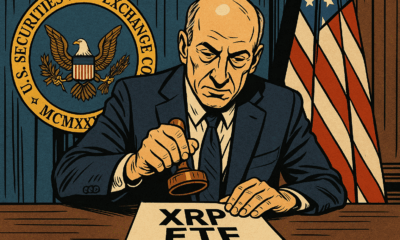News
Ripple CTO Confirms XRP Volume Growth and XBONK Partnerships Reshaping XRPL

- Share
- Tweet /data/web/virtuals/383272/virtual/www/domains/theunhashed.com/wp-content/plugins/mvp-social-buttons/mvp-social-buttons.php on line 63
https://theunhashed.com/wp-content/uploads/2025/09/xrpl-1000x600.png&description=Ripple CTO Confirms XRP Volume Growth and XBONK Partnerships Reshaping XRPL', 'pinterestShare', 'width=750,height=350'); return false;" title="Pin This Post">
Ripple’s Chief Technology Officer, David Schwartz, has recently underscored a series of developments that he believes are positioning the XRP Ledger (XRPL) as an increasingly integral player in both institutional finance and the retail crypto sphere. In remarks cited by CryptoNews, Schwartz highlighted sustained ledger growth, innovations such as Hooks, and memecoin partnerships (specifically with XBONK) as evidence of momentum.
Below, I break down what’s going on, what the claims suggest, and what to watch for going forward.
Ledger Growth, Cost Efficiency, and Institutional Signals
Schwartz emphasized that XRPL has processed over 63 million ledgers continuously for more than ten years — a testament, he argues, to the network’s resilience and consistency. He also pointed out that XRP transaction fees remain extremely low (fractions of a penny), making the network attractive for high-volume use cases and institutional plumbing.
He further noted that at least one bank is planning to “operate fully on XRPL,” which would represent a deeper level of institutional adoption than simply using Ripple’s services or settling rails.
These remarks come in the wake of Ripple’s legal settlement with the U.S. SEC in March 2025, which many in the space interpreted as removing a major legal overhang and opening the door for renewed institutional inflows into XRP.
Technical Upgrades: Hooks, RUX, and the Banking Stack
To enhance XRPL’s utility, Schwartz and Ripple are pushing forward on several fronts:
- Hooks / WebAssembly modules: These are lightweight “smart contract‑like” features intended to bring programmability to XRPL without the complexity or overhead of full-scale smart contract platforms. Currently, they exist on a community testnet.
- Ripple USD (RUX): This is a proposed stablecoin pegged to the U.S. dollar. Schwarz suggested it would be a key liquidity bridge — making it easier to move between yield-bearing crypto assets and stable assets.
- ISO 20022 compatibility: XRPL is being positioned to integrate with global banking messaging standards, making it more interoperable and compliant in traditional finance settings.
Taken together, these upgrades signal that Ripple is trying to straddle both worlds — remaining lean and efficient (a hallmark of XRPL) while adding enough flexibility to remain relevant in evolving blockchain and DeFi landscapes.
XBONK Partnerships: A Memecoin with Ambitions
One of the more eyebrow‑raising aspects of the announcement was the spotlight on XBONK, a memecoin native to XRPL. According to the report, XBONK has inked partnerships or exchange listings with FirstLedger, Bitrue, MEXC, and Gate.io, increasing its accessibility.
Even more ambitiously, XBONK is said to be in talks or partnerships with Walmart and Binance, aiming to be integrated as an “app utility token” within the broader XRPL ecosystem.
The narrative Ripple appears to be pushing: institutional use of XRP will provide the backbone, while retail engagement and liquidity are bolstered through memecoin culture and ease of access.
Skepticism and Risks: What to Watch
While the claims are bold and the narrative compelling, there are several caveats and open questions:
- Technical readiness and maturity
Hooks is still in a testnet phase, and embedding “smart contract‑lite” features in a ledger built for speed and efficiency is not trivial. Bugs, security, or scaling challenges could slow adoption. - Real institutional commitments vs. announcements
Schwartz claims a bank will operate fully on XRPL. But until such a deployment is visible, it remains aspirational. Many crypto projects announce partnerships or pilots that never materialize at scale. - Regulation and compliance
Even post‑settlement, Ripple still must navigate a patchwork of regulatory regimes across jurisdictions. The more “bank-like” features it pushes, the more scrutiny it may attract. - Memecoin volatility & perception
Integrating a memecoin like XBONK into the narrative may help with retail traction, but it also introduces volatility risk and reputational risk if the memecoin fails, is manipulated, or is viewed as too speculative. - Competition from other chains
XRPL is not the only platform trying to bridge traditional finance and crypto. Ethereum, Solana, Avalanche, and stablecoin / payments rails from big tech all compete for the same market positioning.
What to Watch Next
If the momentum is real, here are key indicators to track:
- Bank or financial institution deployments in production (not just pilots)
- Public launches and adoption of Hooks / WebAssembly modules on XRPL
- Uptake and use of Ripple USD (RUX) in cross-asset flows
- Actual utility and integration of XBONK beyond speculative trading
- Transaction growth, wallet activity, and liquidity metrics on XRPL
Conclusion
Ripple’s CTO is painting a bold vision: combining the low-cost, high-throughput backbone of XRPL with smart‑contract‑lite features and memecoin culture to bridge institutional finance and retail crypto. If Ripple can deliver on even a fraction of this roadmap, it could reshape how XRPL is perceived and used in both spheres.
But execution is key, and the crypto world is littered with ambitious plans that failed in the weeds. In the coming months, we’ll see whether XRPL can transform from a payments ledger into a hybrid financial rails network with genuine adoption across institutions and users.
Ethereum
Small Kingdom, Big Move — Bhutan Stakes $970 K of ETH via Figment to Back National Blockchain Ambitions

Bhutan Turns Heads With Institutional‑Grade ETH Stake
The government of Bhutan quietly moved 320 ETH — worth roughly $970,000 — to Figment, the well-known staking provider, signaling a major shift in how the Himalayan kingdom engages with crypto. Rather than a speculative or retail‑style buy, this is an institutional‑level stake: the amount deployed corresponds to 10 full Ethereum validators (since each validator requires 32 ETH).
More Than Just Yield: Bhutan Anchors Crypto in Governance
Bhutan’s ETH stake comes on the heels of a far broader crypto‑adoption push. In October 2025 the country launched a sovereign national digital identity system — built not on a private chain, but on the public Ethereum blockchain. The decision to anchor citizen identities on a decentralized, globally supported network like Ethereum underscores a long‑term vision: decentralized identity, on‑chain transparency, and national infrastructure built with blockchain.
For Bhutan, this ETH stake isn’t about short‑term price swings or hype — it reflects a strategic bet on Proof‑of‑Stake infrastructure. By running validators via Figment, the government contributes to network security, potentially earns rewards, and aligns its own holdings and governance systems with the protocols underlying its digital‑ID rollout.
What This Signals for Ethereum — and for Crypto Governance
Though 320 ETH is a drop in the bucket compared to total staked ETH globally, the move carries symbolic weight. A sovereign state publicly committing funds to ETH staking via a recognized institutional provider adds to the broader narrative: that Proof‑of‑Stake networks are maturing, and that blockchain can underpin more than speculative assets — it can support identity, governance, and long-term infrastructure.
Moreover, it highlights that institutional staking services like Figment are increasingly trusted not only by hedge funds or corporations, but by governments. According to Figment’s own data, their Q3 2025 validator participation rate stood at 99.9%, and they reported zero slashing events — underlining the reliability such clients are counting on.
What to Watch Next
Will Bhutan stake more ETH? On‑chain data shows the wallet still holds a portion of ETH that remains unstaked — suggesting potential for future validator additions.
Will other nations follow suit? If Bhutan’s mixed use of crypto — combining reserve assets, public‑service infrastructure, and staking — proves viable, it could serve as a blueprint for other smaller states looking to modernize governance with blockchain.
Will this affect ETH’s valuation? Hard to say immediately. The 320 ETH is unlikely to move market prices by itself. But if this step becomes part of a larger trend toward institutional and sovereign staking, the cumulative effect on demand and network security could indirectly support ETH’s long-term value proposition.
Altcoins
Meme Coins Are Losing Their Mojo — From 20 % of Crypto Buzz to Just 2.5 % This Year

Meme‑Coin Hype Takes a Hard Hit
A recent report shows that collective interest in meme coins has plunged from about 20 % of all crypto chatter in late 2024 to roughly 2.5 % by October 2025 — a collapse of nearly 90 %. This shift reflects not only a drop in social buzz but also a broader retreat of speculative enthusiasm across the market. What once felt like the wild west of crypto — rapid launches, viral marketing and huge price swings — is cooling fast.
Market Metrics Confirm the Slide
The decline isn’t just anecdotal. Over the past year, more than 13 million meme tokens flooded the market, many with little to no utility — and most quickly vanished or failed. In a sector built on hype, many of these coins turned out to be short‑lived bets. Overall, the fully diluted market capitalization of memes has dropped by nearly 50 % year‑to‑date, according to blockchain analytics firms.
Trading volume has also cratered. In the first quarter of 2025, memecoin trading volume reportedly fell by 63 %. In many markets, memecoins’ share of overall trading volume dropped below 4 %, marking a dramatic retreat from their previous prominence.
What’s Driving the Decline
The collapse appears driven by a mix of oversaturation, weak fundamentals, and shifting investor preference. The meme‑coin ecosystem became overcrowded — tens of millions of projects launched, many with no clear roadmap or utility beyond chasing quick returns. That oversupply, combined with a broader crypto market slump, has wreaked havoc on liquidity and investor confidence.
Some analysts also cite growing regulatory scrutiny and a rising demand for real utility and transparency rather than hype‑driven “get‑rich‑quick” schemes. Meanwhile, capital and attention are rotating toward more tangible crypto sectors — such as AI‑powered tokens, infrastructure projects, DeFi, privacy coins and even traditional‑finance–style crypto instruments.
Could This Be a “Generational Bottom”?
Some within the community argue that the crash may bottom out soon — and that a new cycle could follow. Once the “dead weight” of unsustainable projects is cleared out, more serious, utility‑driven tokens could regain attention. Others believe the meme‑coin era may be effectively over — that the speculative mania has dissipated, and unless a meme coin brings real innovation or value, investors will avoid it.
Broader Implications for Crypto Markets
The downfall of meme coins underscores a broader maturation of the crypto industry in 2025. Markets appear to be shedding excess speculation and gravitating toward assets with fundamentals. This could lead to healthier ecosystem growth, better token design, and more sustainable long‑term investment — but also less room for high‑risk, high‑reward “moonshot” plays that defined crypto’s early years.
Altcoins
NYSE Arca Files to Launch Altcoin-Focused ETF

Fresh Rule‑Change Proposal Seeks Green Light From SEC
A fresh proposal filed by NYSE Arca could soon bring a new kind of cryptocurrency investment product to the U.S. market. In partnership with asset management giant T. Rowe Price, the exchange is seeking regulatory approval to list an actively managed crypto ETF that goes beyond Bitcoin and Ethereum. If approved, the fund would give investors exposure to a mix of top altcoins—like Solana, XRP, Cardano, and more—through a traditional stock exchange, eliminating the need for wallets, private keys, or crypto trading accounts.
What the Fund Would Do: A Broad, Actively‑Managed Crypto Basket
The Fund isn’t a passive single‑asset product but aims for active management. Its objective is to outperform the FTSE Crypto US Listed Index over the long term.
At launch the Fund intends to hold a diversified basket of “Eligible Assets,” which currently include major tokens such as Bitcoin (BTC), Ether (ETH), Solana (SOL), XRP, Cardano (ADA), Avalanche (AVAX), Litecoin (LTC), Polkadot (DOT), Dogecoin (DOGE), Hedera (HBAR), Bitcoin Cash (BCH), Chainlink (LINK), Stellar (XLM), and Shiba Inu (SHIB).
The Fund may hold as few as five, or as many as fifteen, crypto assets at any given time — and is not strictly tied to the index’s weighting. It may over‑ or underweight certain assets, or include crypto outside the index, guided by active selection criteria such as valuations, momentum and fundamental factors.
The idea is to give investors exposure to a diversified crypto portfolio without having to manage wallets, custody, and rebalancing — while potentially delivering better returns than a static, index‑tracking fund.
Risk Controls, Custody and Governance
To ensure safety and regulatory compliance, the Fund will store its crypto holdings with a dedicated crypto custodian. Private keys will be secured under strict controls, preventing unauthorized access or misuse.
When the Fund stakes any crypto (if staking is employed), it will maintain policies to ensure sufficient liquidity to meet redemptions, especially if a large portion of assets becomes illiquid or locked.
Valuation of the crypto holdings — used to compute Net Asset Value (NAV) per share — will rely on reference rates from third‑party price providers, aggregated across multiple platforms. The NAV will be computed daily, aligned with close of trading on the Exchange or 4:00 p.m. E.T.
Why It Matters for Crypto and Traditional Finance
This filing reflects a broader shift in traditional financial markets embracing diversified, regulated crypto investment vehicles. Unlike earlier spot‑crypto ETFs designed for single assets (e.g., Bitcoin), this Fund proposes a multi‑asset, actively managed basket — potentially appealing to institutional investors and diversified‑portfolio allocators seeking crypto exposure with traditional ETF convenience.
If approved, the Fund would offer a streamlined, compliance‑friendly bridge between traditional capital markets and crypto assets, lowering operational friction for investors who prefer not to deal with wallets, exchanges, or self‑custody.
The approach may also set a precedent: showing that active crypto ETFs can meet listing standards under rules originally written for commodity‑based trusts. This could open the door for more innovation — perhaps funds targeting niche themes (smart‑contract tokens, layer‑2s, tokenized real‑assets) while still abiding by exchange and regulatory requirements.
What’s Next
The SEC review period typically spans up to 45 days from publication (or longer if extended), during which comments from market participants and the public may shape the final decision.
If approved, it may take some additional time before shares begin trading — during which documents like the fund’s prospectus, ETF symbol, and listing date will be finalized and disclosed by the sponsor.
-

 Cardano2 months ago
Cardano2 months agoCardano Breaks Ground in India: Trivolve Tech Launches Blockchain Forensic System on Mainnet
-

 Cardano2 months ago
Cardano2 months agoCardano Reboots: What the Foundation’s New Roadmap Means for the Blockchain Race
-

 Cardano2 days ago
Cardano2 days agoSolana co‑founder publicly backs Cardano — signaling rare cross‑chain respect after 2025 chain‑split recovery
-

 Bitcoin2 months ago
Bitcoin2 months agoQuantum Timebomb: Is Bitcoin’s Foundation About to Crack?
-

 Cardano2 months ago
Cardano2 months agoAfter the Smoke Clears: Cardano, Vouchers, and the Vindication of Charles Hoskinson
-

 Cardano2 months ago
Cardano2 months agoMidnight and Google Cloud Join Forces to Power Privacy‑First Blockchain Infrastructure
-

 Ripple2 months ago
Ripple2 months agoRipple CTO David “JoelKatz” Schwartz to Step Down by Year’s End, but Will Remain on Board
-

 News2 months ago
News2 months agoRipple’s DeFi Awakening: How mXRP Is Redefining the Role of XRP










